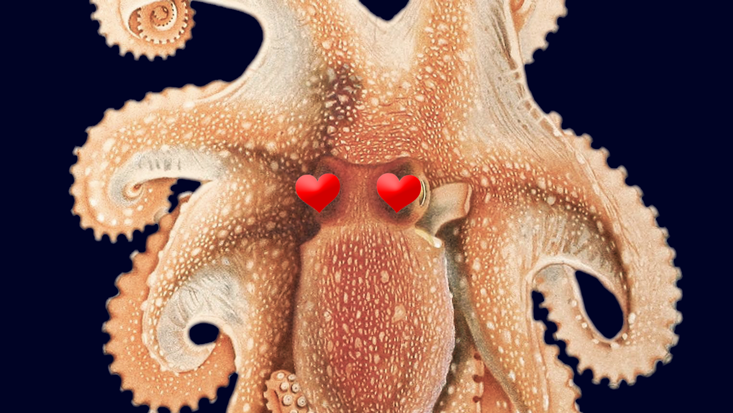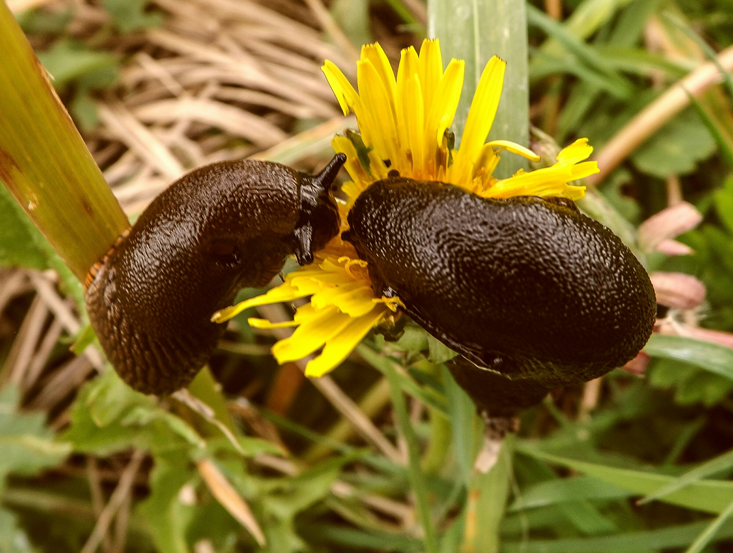Outside of gothic works of fiction set in Transylvania, we rarely read of enduring friendships that have been initiated by a bite. But that is exactly how nature writers Sy Montgomery and Elizabeth Marshall Thomas—the two extraordinary, quirky, and iconoclastic women whose essays are collected in the newly released book Tamed and Untamed—formed their attachment to one another.
Liz and Sy met more than 30 years ago, within months if not weeks of Sy moving to New Hampshire, just minutes away from Liz. Sy was a journalist, writing often about wildlife and soon to embark on her first book, on great apes and the women who studied them. Liz had written classic accounts of life among the San (or Bushmen) hunter-gatherers in the Kalahari Desert as well as novels set in Paleolithic times. As a keen observer of animals, she had also been helping researcher Katy Payne study elephant bioacoustics. So when Sy’s husband, author Howard Mansfield, saw an article about Liz in a local newspaper, he urged Sy to get in touch and, before long, Sy was interviewing Liz about the emerging knowledge of how elephants communicate.

As soon as Sy and Liz sat down together, the two women, who still live in neighboring towns, found common ground talking about the natural world. The discussion that day might have begun with elephants, but it inevitably moved on to lots of other species, including ferrets—Sy’s pet ferrets to be exact. Liz wanted to meet them in person. Sy, eager to oblige, escorted Liz to her house, though she worried that the timing wasn’t optimal. Sy was just back from six months in Australia, and the pet sitter had turned out to be allergic to ferrets. That meant they weren’t very used to being handled. Sure enough, one of the animals did, in fact, sink his pointy teeth into Liz. Sy apologized and started to explain, but she found her defense was completely unnecessary. Liz said—emphatically—that she didn’t mind at all. “She really didn’t mind being bitten by a weasel,” Sy says. And that’s when it hit her. “I knew we were soul mates.”
The two essays below are adapted from Sy’s and Liz’s joint column in the Boston Globe, the newspaper that brought me together with these remarkable women. It’s where I worked as an editor and writer starting in the late 1980s, when Sy was a regular contributor to our Science section. And it was for my own column there, “Animal Beat,” that I interviewed Liz several times. When I discovered somewhere along the way that they were friends, I wanted in. Lucky for me, inclusion comes naturally to them. In fact, it is a hallmark of their work and lives. They’ve always rejected any kind of reflexive exclusion, scientific or personal. Sweet as they are, there’s a real saltiness to their skepticism. They are, one might say, the kettle corn of nature writers.
—Vicki Constantine Croke
Octopus Love
The lights were low. The roses were tied with satin ribbon. Barry White’s sexy bass throbbed on the sound system: “I can’t get enough of your love, babe.” It was Valentine’s Day, and I had big plans to celebrate: I had flown to Seattle to watch two giant Pacific octopuses mate.
Every February 14 for more than a decade, the Seattle Aquarium has hosted the “Octopus Blind Date.” It’s surprisingly popular with children. The year I went, 150 sixth graders, 88 second graders, and kids as young as 5 from at least five other elementary schools lined up in front of the 3,000-gallon, two-part tank, strung with heart-shaped red lights, waiting for the moment that Rain, the 65-pound male, and Squirt, the 45-pound female, would meet. Everyone was eager to see what they would do.

It’s a fraught moment. Despite the plastic roses floating in the tank and the romantic music over the PA, not every blind date works out. Most of their lives, giant Pacific octopuses are solitary. One year one octopus ate the other. (Happily this didn’t happen in front of the public, but after the visitors had gone home.) Another year the female was scared of the male; at his approach she inked and fled. The aquarium’s lead invertebrate biologist, Kathryn Kegel, estimated there was a 50–50 chance that Rain and Squirt would hit it off. If there was a problem, she and another diver, clad in dry suits, would try to separate them. But, she admitted, “There’s too many arms to do much about it, though.” With those 16 arms, plus 32,000 suckers and six hearts (each octopus has three) beating as one, octopus sex would seem to offer possibilities that leave the Kama Sutra in the dust. Not so—at least compared with other seagoing invertebrates. Take the sea slug, Chromodoris reticulata, which lives in shallow reefs around Japan. All have both male and female sex organs—and can use them both at the same time. By contrast, most octopuses usually mate in one of two familiar ways: male on top or side by side.
“Our divers are going to encourage Squirt to come out and meet Mr. Rain,” the aquarium emcee announced to the crowd. Kegel and the other diver then lifted up a Plexiglas barrier that had been separating the two halves of the tank. But Squirt didn’t need much encouragement. Purposefully she flowed from her side of the tank, crawling along the bottom toward Rain, who was sitting on a rock wall at the opposite end.
The murmurs from the humans quietly watching these marine invertebrates—who last shared an ancestor with us half a billion years ago—were tinged with tenderness.
With excellent eyesight as well as sensitive chemoreceptors all over his body, Rain knew very well that she was coming. As she approached, Rain changed color from gray to red—the color of excitement. Squirt stretched two arms toward him, and at her touch, Rain poured down the side of the rock wall. He raced into her arms. She flipped upside down. The two embraced, mouth-to-mouth, thousands of suckers mutually touching and tasting one another. Both flushed red with emotion. And then they were still.
Shortly thereafter the children decamped for their buses. Many of the kids appeared baffled. If human sex was incomprehensible, octopus sex was unfathomable. Aristotle explained octopus mating this way: “The male has a sort of penis on one of his tentacles … which it admits into the nostril of the female.” That’s essentially correct: He uses a specialized arm to place a single, foot-long spermatophore into the large opening on the side of what looks like her head. But what most people think is the octopus’s head is really the mantle, containing most of the organs.
After the kids left, the two octopuses stayed at the bottom of the tank, not moving. Rain’s body covered Squirt’s completely. Rain’s color turned paler and paler. Finally he turned completely white—the color of a relaxed octopus.
The octopuses were not moving, so I watched and listened to the people. Two guys with arms around each other gazed into the tank, watching solemnly and in silence. An elderly couple walked by, the wife leading the husband, who used a walker. “They’re mating, Leo!” she told him. “It’s a very beautiful experience!” The murmurs from the humans quietly watching these marine invertebrates—creatures who last shared an ancestor with us half a billion years ago—were tinged with tenderness: “They’re so peaceful.” “He looks happy.” “They’re beautiful. Just gorgeous.” “So dear. The dear, sweet things.”
It would be difficult to imagine a creature more different from a person than an octopus: We are creatures of the land, they of the sea. We are full of bones, and they haven’t any. They can taste with their skin and squeeze their baggy bodies through tiny openings. We mate early in life and may give birth year after year. Octopuses mate at the end of their lives, and the female lays eggs—up to 100,000 of them—all at once.
And yet, on that Valentine’s Day, the octopuses and people seemed to share the sweetness of the occasion: a celebration of the pleasures of love.
—Sy
Slugs
The names of animals have different connotations. To call someone a pig is fairly insulting, to call someone a louse is highly insulting, and to call someone a slug is exceptionally insulting, implying laziness, stupidity, and uselessness, so I’m wondering how readers will react when I say I’d like to have a slug as a pet. “You want a slug?” someone will cry. “What for?”
Let me explain. After a brief, much-needed rain, I was behind our house checking the rain gauge (we got almost an inch that time) and what did I see but five slugs in the still-damp grass! Two of them were mating—one was on top of another one, anyway—a third slug was at a slight distance, perhaps also thinking of mating, and a fourth and fifth were a few feet away, both minding their own business and evidently relaxed as if they had already mated. Years had passed since I’d seen a slug or even thought about them, so I was excited.

Our planet has many kinds of slugs, which are related to snails, clams, oysters, and octopuses. I don’t know which kind mine were except that they’re known as gastropod mollusks, which means “stomach-foot mollusks,” because like snails they slide along by contracting the skin on their bellies from the waist down while stretching the skin from the waist up, then doing the opposite. Somehow they flow forward smoothly and surprisingly quickly, considering that their featureless bodies look the same from all directions and seem even less complicated, say, than a banana. Their bodies are versatile, however. Like an octopus, a slug can push its body through the tiniest hole, a little at a time. And when they move they squeeze out a small amount of slime, which helps them glide quickly and also protects their undersides from roughness.
But often enough when you look at a slug, you see nothing more than a tiny brownish oval shape that isn’t moving. So what surprised me when I saw the slugs in question was their awareness, especially from the two slugs mating, as if the slug on top felt the need to understand his surroundings. Slugs are hermaphrodites, having both male and female organs, but the slug on top seemed to be taking the male role. His rear end (I use his because of the role he was playing) seemed to be adorned with tiny, dark protuberances not evident on the slugs that weren’t mating, and was partly wrapped around the slug below. He seemed to feel responsible for the safety of them both because he appeared to sense my proximity. Up from his pale brown front end came one of his eyes. Nothing happened for a while, so I moved a little closer, and up came the other eye.
If a single-cell organism can learn and remember things, and if birds and fish can recognize individual humans, who knows what a slug can achieve?
A photo of a slug usually shows her (I don’t like to call an animal “it”) with what looks like a V shape of two tiny horns made of the same material as the rest of her body. These come up from her front end and carry her eyes. At the tip of each horn is an eyespot. Not all slug species have these eyespots, but these slugs did, complete with lenses with which they see objects as we do but not in color. If a slug doesn’t feel the need to look at something, she pulls her eyes back down into her body, where they disappear without a trace.
If eyes suggest a forehead, then two other sense organs come out of her chin—two much smaller horns that inform her of taste and scent. The sense of touch is in her entire body. She has no sense of sound but perhaps can feel vibrations. The slug I watched didn’t put out his taste and scent organs, perhaps because he wasn’t overly concerned. He even withdrew one of his eyes and left only the other to keep track of me.
We tend to see the slug types as disgusting. Surely they’re damaging our flower beds or doing something else that’s awful so we stamp on them or even put out poisons. But any life form is fascinating if you watch it long enough, and the small, slow-moving animals are particularly favorable because you can watch any one of them indefinitely and note all kinds of behaviors. Just think what you could learn by watching slugs—not when you’re high above them on a rain-dampened lawn, but at eye level beside a glass aquarium planted with moss and other vegetation, complete with their favorite foods and easy access to water. I’d learn from them and find out if they’d learn from me. If a single-cell organism can learn and remember things, as has been demonstrated with paramecia, and if birds and fish can recognize individual humans (most humans can’t recognize individual birds or fish), who knows what a slug can achieve?
A marvelous book was written on this subject, The Sound of a Wild Snail Eating by Elisabeth Tova Bailey. It’s about a snail while this essay is about a slug, but they’re the same thing, really—a snail is a slug with a shell. I can’t get enough of this book—it opens a world of utterly fabulous creatures that most of us know nothing about. After you read it, you will never again see a snail or a slug without marveling. You might even want one as a pet.
—Liz
Sy Montgomery and Elizabeth Marshall Thomas are New York Times bestselling authors and two of the world’s most celebrated animal writers. Tamed and Untamed, their first-ever collaboration, is an engaging collection of essays that offer extraordinary insights into the minds, lives, and mysteries of animals.
From the Book: Tamed and Untamed: Close Encounters of the Animal Kind Copyright © 2017 by Sy Montgomery and Elizabeth Marshall Thomas Published by Chlesea Green Publishing
Lead Photocollage Credit: Stasis Photo / Shutterstock


























